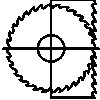-
Posts
129 -
Joined
-
Last visited
Reputation Activity
-
 lehmann got a reaction from CiscoH in Re-hardening Brass
lehmann got a reaction from CiscoH in Re-hardening Brass
Copper and copper alloys, such as brass, can only be hardened by work hardening. This is usually done by running a sheet between rollers, or it can be done by drawing (pulling a wire through a hole smaller than the diameter of the wire). Hardening can also be done by beating with a hammer, but the results will be uneven, to say nothing of the resulting uneven thickness. At some point the material becomes brittle, which may limit the amount of bending possible for your part. In a rolling plant, the sheets get hard after a few rolls, and so, they need to be heated (tempered) to soften them so the thickness can be reduced some more.
Iron, is also hardenable by working, but the amount is limited. Hardening cannot be achieved by heating and quenching (rapid cooling) unless the carbon content is greater than 0.12%. This limit basically defines the difference between iron and steel. To go beyond this, other elements are added, creating alloys. On the topic of alloys, brass is an alloy of copper and zinc; bronze, is an alloy of copper with tin, phosphorus, aluminum, nickle or silicon.
Aluminum can also be hardened, but this is mostly done by precipitation or solution hardening, where the material is kept at a certain temperature for period of time. The hardness is designated by a "T" code, as in 6061-T4, which is the most common grade of aluminum.
We work in brass and copper in models because they are easy to work, easy to solder or braze, and are corrosion resistant. We could use stainless steels (there are many grades), but they tend to be quite hard, as anyone who has tried to drill and tap a 4-40 thread in stainless knows. Aluminum has some of the same properties of brass, but it's very hard to join, although I've seen some aluminum "solders'. Although aluminum is corrosion resistant, it does form a soft oxide layer that comes off easily.
Probably more than you wanted to know, but now that it's been emptied from my brain, I have room to learn something else....
-
 lehmann got a reaction from GRATEFUL LITTLE PHISH in Filler Blocks
lehmann got a reaction from GRATEFUL LITTLE PHISH in Filler Blocks
Filling all the gaps is probably not a good idea, although tempting. On another post (Drazen), someone had filled all the spaces between frames with solid wood. The problem is that wood will move with humidity, and he ended up with cracks in the planking, especially at points where the filler piece wanted to move and the plywood bulk head didn't. The lessons from that, at least for me, were:
leave a gap between the filler and the bulkhead. If not a gap, put a soft layer of cardboard that can flex and shear as the wood moves align the grain of the filler with the grain of the planking. Wood doesn't change length much with humidity, but it does change length. Over-constraining wood structures is never a good thing. There was also a discussion that the change in width of a plank with humidity for flat grain boards is almost twice that of edge grain.
Overall, I would add more bulkheads: fit them in as best as possible then fair them. This is how "real" ships are built and it eliminates the flat spots when the bulkhead spacing is large and gives more points to tie to when bending around hard curves.
-
 lehmann got a reaction from mtaylor in How to sail a square rigger?
lehmann got a reaction from mtaylor in How to sail a square rigger?
For a modern book, look for the US Coast Guard manual for their square rig training ship Eagle. Available on Amazon and Abe Books.
Eagle Seamanship: A Manual for Square-Rigger Sailing by Christopher Nolan USCG and Eric C Jones
-
 lehmann got a reaction from Altduck in Proportional Dividers
lehmann got a reaction from Altduck in Proportional Dividers
I bought one on eBay. Good ones are not cheap, which is amazing considering the general demise of manual drafting and the availability of cheap digital calipers. However, after examining their construction, I can see why they're not cheap - if there are errors in certain lengths and positions then the scale settings will be off enough to be very exasperating. They are a very different animal from regular dividers.
There are some plastic versions available - I have one of these as well, but I think they are more for artists to scale a picture rather than for drafting. The major limitation of mine is that the ratio is adjusted by moving the pivot to holes of fixed locations so that ratios of only 1:1, 1:2, 1:3 are possible.
I use them fairly often, and not just for model building. As others have said, if you're working a kit boat, you won't need proportional dividers. But if you're mashing drawings from different scales, they're a real time saver.
As a poor-man's option if you only have standard dividers, I've attached an example of a grid I use for a converting between 1:72 and 1:96. I used a CAD program, but you can make a satisfactorily accurate version by hand.
72_96Scale.pdf
Set the dividers on the dimension on the 1:72 drawing Place the dividers on horizontal base line Pivot from the right point of the dividers Set the dividers to span up to the diagonal line The dividers are now at the distance needed for the 1:96 drawing -
 lehmann got a reaction from Clark Griswold in Can this wood be saved?
lehmann got a reaction from Clark Griswold in Can this wood be saved?
Pre-bend planking: looks like a feature you should have paid more for.
I would just wet the areas with the hardest bends/twists to avoid creating fuzzy grain and water stain. Maybe heat with hot iron. The longer, slower bends should straighten out as needed, although if you're planning to rip into strips, they could be awkward.
What is the intended use?
-
 lehmann got a reaction from mtaylor in Rigging Supplies
lehmann got a reaction from mtaylor in Rigging Supplies
Greetings from the Mainland,
What are the diameters of the seine twine?
I just bought a spool of the AWF 60 lb test bright wire from Amazon for a totally different purpose - to restring my parallel ruler on my drafting board. Remember to remove the nylon coating for your model. This wire is stainless steel, so it would be good to know if it can be blackened. Lastly, some people may want to know the diameters by test.
-
 lehmann reacted to trippwj in Difference between editions of David Steel's books on rigging etc
lehmann reacted to trippwj in Difference between editions of David Steel's books on rigging etc
For those with an interest in the 1794 version reprinted in the original size, DN Goodchild offers the following:
Hardcover Elephant Folio
STEEL'S ELEMENTS OF MASTMAKING, SAILMAKING AND RIGGING
edited by Claude S. Gill
A reprint of the 1794 edition with five very large pocketed plates. An essential reference to the ship modeler and all who love early square rig. Every conceivable aspect of rigging and sails is covered here, including a number of tables for the dimensions of the standing and running rigging. There is also an excellent section with very fine engravings of all known types of sailing vessels at the time; including many that are rare indeed, and many from Asia and the Pacific. Those of you who read and treasure Patrick O'Brien will find this work a ready reference for rig and ship types. First published in 1794.
Publisher's Note: Our reprint restores the Elephant Folio (11" X 17") sizing of the original volume which was reduced in the 1932 reprint which has been out of print for some years.
Arranged, with an introduction by Claude S. Gill, 300 pages, $65.00
-
 lehmann got a reaction from BobG in Measurement tools?
lehmann got a reaction from BobG in Measurement tools?
There are digital dividers, such as IGaging Digital Divider/Compass Not cheap, but not exorbitant.
However, before becoming obsessed with small measurements, remember that it is also not possible to manually draw small objects accurately. CAD can do better, but there is still always a line width that is typically several pixels wide.
If the part is small, the dimensions should correspond, in scale, to something a person can pick up or grab by hand. So, adjust your numbers accordingly. Actually, for small parts it's the relative dimensions (proportion) that matter the most. For instance, a ship's wheel. The diameter is easy to measure, but the spokes and handles have be in proportion otherwise it will look like a gear. The eye and brain can be fooled by scale, but they pick up errors in proportion easily. Making small adjustments to ensure proportion, or the appearance of proportion, is one of the skills of modelling.
If the part is bigger, then scaling with the points of calipers should be close enough. At 1/8 to the foot scale, 0.005 inches, which is obtainable with calipers on a drawing, is only 1/2 inch in full size.
-
 lehmann got a reaction from mtaylor in Measurement tools?
lehmann got a reaction from mtaylor in Measurement tools?
There are digital dividers, such as IGaging Digital Divider/Compass Not cheap, but not exorbitant.
However, before becoming obsessed with small measurements, remember that it is also not possible to manually draw small objects accurately. CAD can do better, but there is still always a line width that is typically several pixels wide.
If the part is small, the dimensions should correspond, in scale, to something a person can pick up or grab by hand. So, adjust your numbers accordingly. Actually, for small parts it's the relative dimensions (proportion) that matter the most. For instance, a ship's wheel. The diameter is easy to measure, but the spokes and handles have be in proportion otherwise it will look like a gear. The eye and brain can be fooled by scale, but they pick up errors in proportion easily. Making small adjustments to ensure proportion, or the appearance of proportion, is one of the skills of modelling.
If the part is bigger, then scaling with the points of calipers should be close enough. At 1/8 to the foot scale, 0.005 inches, which is obtainable with calipers on a drawing, is only 1/2 inch in full size.
-
 lehmann got a reaction from CPDDET in Measurement tools?
lehmann got a reaction from CPDDET in Measurement tools?
There are digital dividers, such as IGaging Digital Divider/Compass Not cheap, but not exorbitant.
However, before becoming obsessed with small measurements, remember that it is also not possible to manually draw small objects accurately. CAD can do better, but there is still always a line width that is typically several pixels wide.
If the part is small, the dimensions should correspond, in scale, to something a person can pick up or grab by hand. So, adjust your numbers accordingly. Actually, for small parts it's the relative dimensions (proportion) that matter the most. For instance, a ship's wheel. The diameter is easy to measure, but the spokes and handles have be in proportion otherwise it will look like a gear. The eye and brain can be fooled by scale, but they pick up errors in proportion easily. Making small adjustments to ensure proportion, or the appearance of proportion, is one of the skills of modelling.
If the part is bigger, then scaling with the points of calipers should be close enough. At 1/8 to the foot scale, 0.005 inches, which is obtainable with calipers on a drawing, is only 1/2 inch in full size.
-
 lehmann got a reaction from mtaylor in The saws that cut the wood that made the ships.
lehmann got a reaction from mtaylor in The saws that cut the wood that made the ships.
Spear & Jackson is still around, although they have merged with other companies, as has happened to Disston Saw. They are no longer making the larger saws used in sawmills and ship yards, but they were still applying for patents for insert teeth (Figure 79, page 64) in the 1980's. Several people I worked with did their saw-maker/saw-filer apprenticeship at S&J plant near Vancouver, Canada.
-
 lehmann got a reaction from druxey in The saws that cut the wood that made the ships.
lehmann got a reaction from druxey in The saws that cut the wood that made the ships.
Spear & Jackson is still around, although they have merged with other companies, as has happened to Disston Saw. They are no longer making the larger saws used in sawmills and ship yards, but they were still applying for patents for insert teeth (Figure 79, page 64) in the 1980's. Several people I worked with did their saw-maker/saw-filer apprenticeship at S&J plant near Vancouver, Canada.
-
 lehmann got a reaction from bruce d in The saws that cut the wood that made the ships.
lehmann got a reaction from bruce d in The saws that cut the wood that made the ships.
Spear & Jackson is still around, although they have merged with other companies, as has happened to Disston Saw. They are no longer making the larger saws used in sawmills and ship yards, but they were still applying for patents for insert teeth (Figure 79, page 64) in the 1980's. Several people I worked with did their saw-maker/saw-filer apprenticeship at S&J plant near Vancouver, Canada.
-
 lehmann got a reaction from mtaylor in Sitka Spruce
lehmann got a reaction from mtaylor in Sitka Spruce
Agree. Spruces all have a definite late-wood "line" with a softer early-wood between. The wood has a high strength to weight ratio, hence the use in spars and airplanes, but only if the grain is straight and the edges of the board are parallel to the grain (no grain angle or run-out).
Some sawmills in my area ( British Columbia, Canada) are still occasionally cutting Sitka spruce, but mostly for Asian markets, which are willing to pay high $. Logs that meet the standards for a Japanese temple log can sell for $30,000. A wedge for making cello backs sold for $130 (20 years ago!).
As to how the sample ended up in Australia, there has long been a export trade from British Columbia and Alaska with Australia. Direct delivery by ship.
-
 lehmann got a reaction from druxey in Sitka Spruce
lehmann got a reaction from druxey in Sitka Spruce
Agree. Spruces all have a definite late-wood "line" with a softer early-wood between. The wood has a high strength to weight ratio, hence the use in spars and airplanes, but only if the grain is straight and the edges of the board are parallel to the grain (no grain angle or run-out).
Some sawmills in my area ( British Columbia, Canada) are still occasionally cutting Sitka spruce, but mostly for Asian markets, which are willing to pay high $. Logs that meet the standards for a Japanese temple log can sell for $30,000. A wedge for making cello backs sold for $130 (20 years ago!).
As to how the sample ended up in Australia, there has long been a export trade from British Columbia and Alaska with Australia. Direct delivery by ship.
-
 lehmann got a reaction from Canute in WRITER’S BOAT MODELS
lehmann got a reaction from Canute in WRITER’S BOAT MODELS
One boat missing from your list is the Spray - Josha Slocum. Blue Jacket models has a kit: http://www.bluejacketinc.com/kits/spray.htm
-
 lehmann got a reaction from thibaultron in WRITER’S BOAT MODELS
lehmann got a reaction from thibaultron in WRITER’S BOAT MODELS
One boat missing from your list is the Spray - Josha Slocum. Blue Jacket models has a kit: http://www.bluejacketinc.com/kits/spray.htm
-
 lehmann got a reaction from mtaylor in WRITER’S BOAT MODELS
lehmann got a reaction from mtaylor in WRITER’S BOAT MODELS
One boat missing from your list is the Spray - Josha Slocum. Blue Jacket models has a kit: http://www.bluejacketinc.com/kits/spray.htm
-
 lehmann got a reaction from Jorge Diaz O in Micro Chisels
lehmann got a reaction from Jorge Diaz O in Micro Chisels
I have a set of micro-chisels made by DockYard tools that were, but no longer, sold by Lee Valley. However, I see that they are available from other suppliers. These are the smallest chisels and knives I have seen as the blanks are more of a wire than a bar or rod. Definitely, not tools for roughing. However, the steel is good in that I can get a razor edge on them.
I also have a set of small chisels that Lee Valley sells (part 81D40.01 ). I thought they would be just good for scraping, but the steel is remarkably good so I got very sharp edges. The set included two fish-tails, which are difficult to find in such a small size.
I've made a few small knives/chisels from broken (or sacrificed) drill bits. This is probably the cheapest source of tool steel available.
-
 lehmann got a reaction from EricWilliamMarshall in Rikon 70-100 woodworking mini-lathe
lehmann got a reaction from EricWilliamMarshall in Rikon 70-100 woodworking mini-lathe
The Taig lathe is easy and fast to change from metal to wood and vise versa. First, just slide off the tail-stock. The carriage for metal working and the tool rest mounts for woodworking just slide on/off on the dove-tail base.
There is a wide range of speeds that can be quickly changed on the stepped pulley from the motor. The Taig web site lists 520-5200 rpm.
The gibs on the metal working carriage can be set up quite tight without any sticking for the whole range of travel, so the setup is very rigid. As for the rigidity of the base, I used my circular saw setup to cut some nylon sheet a few weeks ago - a tough cut - but, even when the belt was slipping there was no vibration or chatter.
Length of the bed is 15 inches, but the distance between centers is 9.75 inches.
As for the reference to alchemy, the lathe cannot covert wood into metal, but it does transform base square stock to perfect rounds.
-
 lehmann got a reaction from mtaylor in Need CAD type program
lehmann got a reaction from mtaylor in Need CAD type program
Draftsight is a free, fully functional 2D drafting program from the same company that produces SolidWorks (3D cad). Basically, a similar program to AutoCad or TurboCad. I've run it on both Windows and Linux systems
-
 lehmann got a reaction from trippwj in Need CAD type program
lehmann got a reaction from trippwj in Need CAD type program
Draftsight is a free, fully functional 2D drafting program from the same company that produces SolidWorks (3D cad). Basically, a similar program to AutoCad or TurboCad. I've run it on both Windows and Linux systems
-
 lehmann got a reaction from Canute in Blackening revisited
lehmann got a reaction from Canute in Blackening revisited
I recently pickup this pickling chemical from a local jewelry supplier.
Pro-Craft Pickling compound (No. 45.122): Sodium Bisulfate. 10 oz bottle makes 1 quart. Solution works well at room temperature, but faster at about 125 F.
-
 lehmann got a reaction from thibaultron in Blackening revisited
lehmann got a reaction from thibaultron in Blackening revisited
I recently pickup this pickling chemical from a local jewelry supplier.
Pro-Craft Pickling compound (No. 45.122): Sodium Bisulfate. 10 oz bottle makes 1 quart. Solution works well at room temperature, but faster at about 125 F.
-
 lehmann got a reaction from mtaylor in Blackening revisited
lehmann got a reaction from mtaylor in Blackening revisited
I recently pickup this pickling chemical from a local jewelry supplier.
Pro-Craft Pickling compound (No. 45.122): Sodium Bisulfate. 10 oz bottle makes 1 quart. Solution works well at room temperature, but faster at about 125 F.












.thumb.jpeg.fc5d633a7b34428fcf19419a73d56d55.jpeg)
